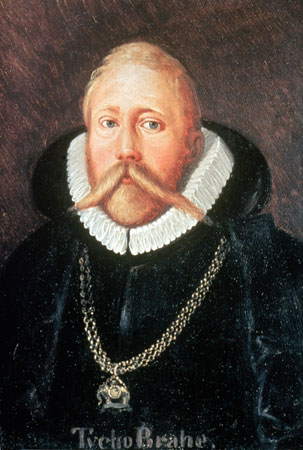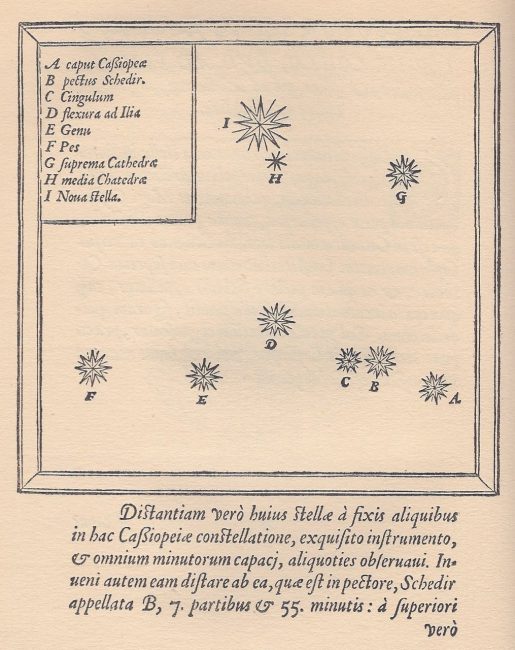
Tycho Brahe (1546-1601)
On December 14, 1546, Danish nobleman and astronomer Tycho Brahe, known for his accurate and comprehensive astronomical and planetary observations was born.
“Non haberi, sed esse.”
“Not shine, but be.”
– Tycho Brahe’s Election slogan
Background
Tycho Brahe was born at Knutstorp Castle, Scania, at that time Denmark, into a politically powerful family of noblemen and political advisors. He grew up with his uncle, also a nobleman, who supplied his nephew with a proper education at a Latin school. Tycho began attending the university of Copenhagen at the age of 12 with the propaedeutic study of Artes Liberales, consisting of the subjects Grammar, Dialectic, Rhetoric (Trivium) and Arithmetic, Geometry, Music, Astronomy (Quadrivium). In favor of his uncle he studied law but a solar eclipse in 1560 aroused Tycho’s great interest in astronomy, and so he began to delve into the subject. He read every book he could get and made stargazing observations over and over again. In the following years he continued his studies at the universities of Leipzig, Wittenberg, Rostock and Basel. Still at university, Tycho Brahe began performing his first observations and soon noticed the need of more accuracy and better schemes. Inadequate observation methods of observatories at that time led to his early interest in the methodology and instruments for measuring the height precision of celestial bodies. However, it is to note, that he performed all observations without a telescope, which first appeared in the mid 1600’s.
The Golden Nose and other Mysteries
Despite his achievements in astronomy, Tycho Brahe was also very well known for his ‘golden nose’. During a duel over a mathematical formula in the dark with Manderup Parsberg, he lost parts of his nose,and rumors spread that he had used a prosthesis made of gold or sometimes silver. Later observations on the astronomer assumed that he was wearing a nose made of copper instead, and the most recent research results suggest that is was rather made out of brass.
Also mystical is the the death of Tycho Brahe in the year 1601. For a long time it was cause of controversies, because the one side of historians argues that he had suffered from a bladder or kidney ailment after attending a court banquet in Prague while the other sides assumes that he might have been poisoned with quicksilver.
Tycho Brahe in Astronomy

Star map of the constellation Cassiopeia showing the position of the Supernova of 1572
But, coming back to the astronomer Tycho Brahe, his critical contributions are to be mentioned. In 1572 Brahe, together with his sister Sophie Brahe, observed a supernova, “a miracle not seen since the beginning of the world”. His writing about the “new star never seen before” made him famous among astronomers throughout Europe. The observation was even a major inspiration for the poem ‘Al Aaraaf by Edgar Allan Poe.[8] Also, Tycho built an observatory in 1576, which he was able to develop into a whole research center for nearly 100 students and scientists. Another observatory was built by Tycho Brahe near Prague, where he performed numerous experiments and observations for many noblemen, including weather forecasting or interpreting major astronomical events.
![Although Tycho admired Copernicus and was the first to teach his theory in Denmark, he was unable to reconcile Copernican theory with the basic laws of Aristotelian physics, which he believed to be foundational. He was critical of the observational data that Copernicus built his theory on, which he correctly considered to be inaccurate. Instead, Tycho proposed a "geo-heliocentric" system in which the Sun and Moon orbited the Earth, while the other planets orbited the Sun. His system had many of the observational and computational advantages of Copernicus' system. It provided a safe position for those astronomers who were dissatisfied with older models, but reluctant to accept heliocentrism.[79] It gained a following after 1616, when the Catholic Church declared the heliocentric model to be contrary to philosophy and Christian scripture, and only able to be discussed as a computational convenience.[80] Tycho's system offered a major innovation in that it eliminated the idea of transparent rotating crystalline spheres to carry the planets in their orbits. Kepler and other Copernican astronomers, tried unsuccessfully to persuade Tycho to adopt the heliocentric model of the Solar System. To Tycho, the idea of a moving Earth was "in violation not only of all physical truth but also of the authority of Holy Scripture,](http://scihi.org/wp-content/uploads/2018/12/Tychonian_system.svg_-650x650.png)
The Tychonic system, surrounded by a sphere of fixed stars. The Moon and the Sun are shown orbiting the Earth, and five planets orbit the Sun.
Tycho’s Fabulous Accuracy
King Frederick II of Denmark and Norway financed the Uraniborg and Stjerneborg observatories on the then still Danish Öresund island of Ven off Landskrona, which Brahe researched for 21 years. Brahe not only built all the instruments he needed himself, but also printed his own books. Due to his enormous accuracy, Tycho and his observational data were a great influence to later astronomers, including the great Johannes Kepler.[9] Tycho Brahe was an outstanding observational astronomer. At his time there was no telescope. His observations of the fixed star and planetary positions, which were by far the most precise at that time and cannot be easily reached with an accuracy of two arc minutes even today, were carried out with the help of a large wall quadrant. Due to contradictions in the planetary movements in the world systems prevailing at the time, he developed a compromise between the Ptolemaic-geocentric and the Copernican-heliocentric planetary systems, which was called the Tychonic world view.
Tycho’s records were critically for his work on the heliocentric model of the solar system. However, Tycho developed his own system. In it, the Moon and the Sun would revolve around the Earth while Mercury, Venus, Mars, Jupiter, and Saturn revolved around the Sun. This system is also called the geo-heliocentric system and depicted a contrast to the system by Copernicus. It was also less disliked by the church and many fellow astronomers.
Later Years
After Frederick II’s death in 1588, his successor King Christian IV cut the financial means, which is why Brahe moved to one of his manor houses, Wandesburg near Hamburg, in October 1597 at the invitation of his friend Heinrich Rantzau. In September 1598 Brahe left Wandsbek with his sons and students and moved to Prague in 1599. Emperor Rudolf II had offered him a position as court mathematician and wanted to have a new observatory built for him there. However, the construction was not finished until after Brahe’s death. Brahe stayed from August 1599 to June 1600 in the quiet town Benátky nad Jizerou. He died in Prague in 1601. His wife Kirstine bought a manor in Bohemia, which she lived in for three years until her death. Tycho and Kirstine Brahe were buried side by side in the Tyn Church in Prague.
“Don’t let my life have been in vain.”
– Tyvho Brahe, Last Words, October 24, 1601
Ian Morison, Tycho Brahe’s Life and Death, [4]
References and Further Reading:
- [1] Tycho Brahe Biography at MacTutor History
- [2] Tycho Brahe at the University of Cambridge
- [3] Tycho Brahe at Wikidata
- [4] Ian Morison, Tycho Brahe’s Life and Death, 2010, Gresham College @ youtube
- [5] Edmund Halley and his famous Comets
- [6] Fred Hoyle and the Big Bang Theory, SciHi Blog
- [7] The Supernova of 1054, SciHi Blog
- [8] The Mysterious Death of Edgar Allan Poe, SciHi Blog
- [9] And Kepler Has His Own Opera – Kepler’s 3rd Planetary Law, SciHi Blog
- [10] Works of or about Tycho Brahe via Wikisource
- [11] Tycho Brahe at the Mathematics Genealogy Project
- [12] The Prof says: Tycho was a scientist, not a blunderer and a darn good one too!, at The Renaissance Mathematicus, March 6, 2012.
- [13] Tycho Brahe Timeline via Wikidata






Pingback: Whewell’s Gazette: year 2, Vol. #23 | Whewell's Ghost
Pingback: Whewell’s Gazette: Year 03, Vol. #18 | Whewell's Ghost